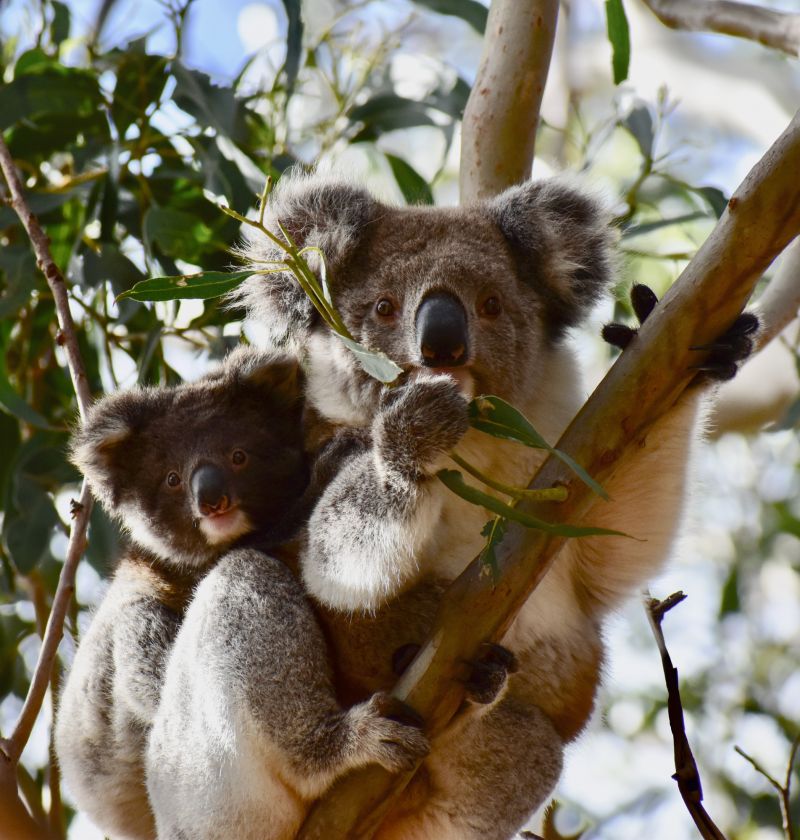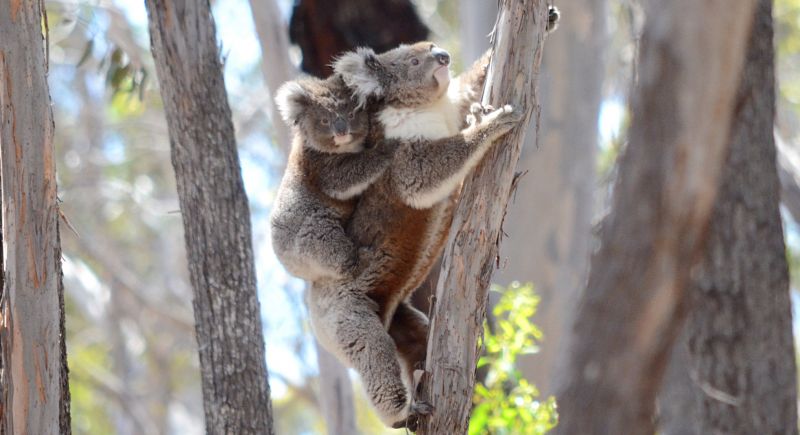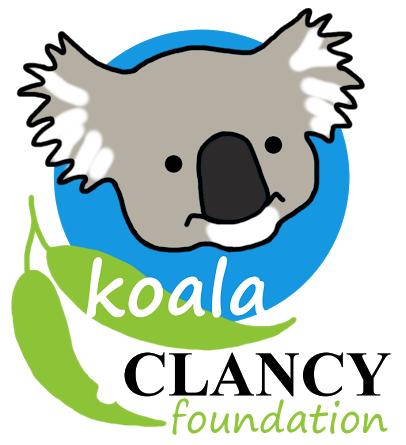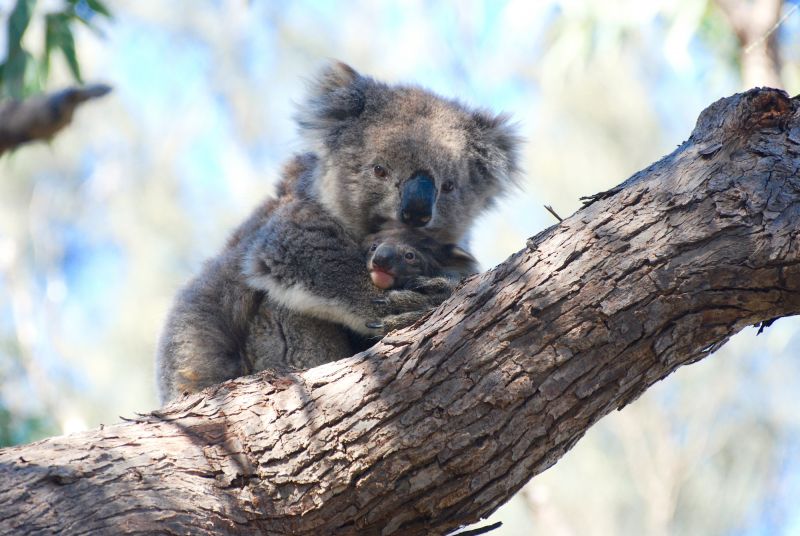The Koala (Phascolarctos cinereus) is one of Australia's most iconic animals. They are so unique that they have their own genus as well as their own family!
Where are Koalas found in Australia?
Koalas are found across south-eastern Australia, which includes South Australia, Victoria, New South Wales and southern Queensland, however, there is fossil evidence of Koalas living in south-west Western Australia, central Australia and northern Australia in the past.
Koala habitat consists of river valleys, tall Eucalypt forests and low inland woodlands.
What are the physical features of the Koala?
For many visitors to Australia, the Koala is the most adored of all the Australian species! They actually differ slightly in appearance by region. In northern New South Wales and southern Queensland, Koalas are light grey in colour, have shorter fur and larger ears.
In the southern regions across South Australia and Victoria, they are more of a dark brown colour with longer fur to protect them from the cooler climate.

Image: Exceptional Kangaroo Island
How big are they?
In southern Australia, Males will have an average weight of around 12kg (26lb) and a height of around 78cm (2.6ft). Females will have an average weight of around 8.5kg (19lb) and a height 72cm (2.4ft).
In northern New South Wales and southern Queensland, they are are much smaller. Here, males will have an average weight of around 6.5kg (14lb) and a height of around 70cm (2.3ft). Females will have an average weight of around 5kg (11lb) and a height 68cm (2.2ft).
The Koala diet
Despite feeding solely on Eucalyptus leaves, Koalas are actually very fussy eaters.
Out of Australia's 600+ eucalypt species, they will only eat approximately 35 of them.
In fact, they will starve before eating leaves that are too high in tannins or oils. These tannins and oils are actually part of the defence of the trees, against being eaten by insects (or Koalas)!

Image: Echidna Walkabout Nature Tours
Sleep, eat, sleep and repeat
Koalas are well known for their sleeping requirements, which is generally between 18 and 22 hours per day! When they aren't sleeping, they're eating. In fact, all of this eating is what causes their amazing sleep schedule.
Due to the low nutritional value of the leaves they consume, they need to eat more to survive which means more work for their digestive system. All of this digestion takes a lot of energy, so they conserve that energy by sleeping.
Koala breeding
In a habitat with plenty of food and water, females will produce one young 'joey' per year.
Mating occurs from August through to February, which is the Australian spring/summer. During this time, males will become more vocal and will be seen fighting with competing males in order to win over the female of common interest.
Following a gestation period of only one month, the young Koala is born and will find it's way to the mother's pouch to attach itself to the milk teat. As the joey grows, it will spend more time out of the mother's pouch, often found clinging onto the back. Once old enough, the young will leave it's mother to become solitary.

Image: Exceptional Kangaroo Island
Where can I see the Koala with an expert guide?
Kangaroos and Koalas in the Wild (1D)
Operator: Echidna Walkabout Nature Tours
Region: You Yangs, Victoria
Traversing through captivating natural bushland across the You Yangs and Serendip National Parks, this one day adventure provides you with up-close encounters with Australia’s most endearing animal, the Koala!
Travelling 45 minutes from Melbourne, guests will reach the magnificent open woodland of the You Yangs Ranges. The park is home to a healthy population of wild Koalas, which the wildlife guides research to ensure premium sightings.
Southern Highlands Wildlife Day Tour (1D)
Operator: Boutique Wildlife Tours
Region: Southern Highlands, New South Wales
Venture to the pristine bushland of the Southern Highlands, just 90 minutes from Sydney, to observe several of Australia's most iconic species in the afternoon and evening!
Guests will escape the busy city afternoon to the tranquil environment of the Southern Highlands in search of Australia’s most beloved species including wild Eastern-grey Kangaroos, Koalas, Red-necked Wallabies, Common Wombats, Platypus and many bird species.
Port Lincoln Wildlife Encounters (2D/2N)
Operator: Australian Coastal Safaris
Region: Eyre Peninsula, South Australia
This incredible two day adventure combines the best terrestrial and marine protected areas across the region including Lincoln National Park, Coffin Bay National Park, Big Swamp, Mikkira Station and Mount Dutton Bay Conservation Park.
Guests will venture out to beautiful Mikkira Station to see a colony of wild Koalas. Whilst strolling under the beautiful old Eucalypt trees, guests will be in awe as they come face to face with the cuddly icon of Australia as they laze in the Manna gums.
Kangaroo Island In Style Tour (2D/1N)
Operator: Exceptional Kangaroo Island
Region: Kangaroo Island, South Australia
This tour combines the two most popular full day landscape and wildlife experiences; Island Life and Flinders Chase Focus. Guests will be exposed to a broad range of elements including the Island's history, ecology, wildlife, landscape and contemporary lifestyle. Iconic landscapes in the southwest corner will deliver endless photographic opportunities especially at Remarkable Rocks, Admirals Arch and Cape du Couedic.
Regular wildlife encounters include Koalas, Australian Sea-lions, Long-nosed Fur Seals, Tammar Wallabies and Kangaroo Island Kangaroos, with Short-beaked Echidnas, Glossy Black Cockatoos, Rosenberg's Goanna (warmer months) and a range of bush and shore-birds sighted often.
Murray River Safari (4D/3N)
Operator: Murray River Safari
Region: Riverland, South Australia
Explore the most picturesque sections of Australia's greatest river, combining the comforts of houseboat accommodation with a multi-activity guided wildlife safari.
Regular wildlife encounters include Koalas, Western Grey Kangaroos, Short-beaked Echidnas, Lace Monitors, Australian Pelicans, Royal Spoonbills, Black Swans, Wedge-tailed Eagles, parrots and honeyeaters.

Image: Echidna Walkabout Nature Tours
Koala conservation issues
Since European settlement in the late 1700s and early 1800s, Koala numbers have fallen due to the clearing of key habitat areas across south-eastern Australia. Organisations such as the Koala Clancy Foundation are helping to reverse the decline in Koala numbers.

Koala Clancy Foundation - Echidna Walkabout Nature Tours
Koalas are one of the ten species worldwide most at risk from climate change. Increased carbon dioxide in the air is changing the chemical composition of eucalyptus leaves, making it harder for koalas to find food.
In the seven years from 2007 to 2014, Echidna Walkabout Nature Tours documented a 46% decrease in Koala numbers in the You Yangs. However, koala sightings have increased in one region of the You Yangs - an area where we conduct our Make a Home for Koala Clancy weed removal project. Removing Boneseed weeds does help koalas.
We are passionate about our environment and our future depends on us to take action. Working together, we have a chance to create a world where our children – and the children of the future – can celebrate wildlife and appreciate Koalas IN THE WILD.
The Foundation began in July 2015 in response to this decline in koalas in the You Yangs. The foundation takes over and supports the conservation and research work began by Echidna Walkabout Nature Tours, a social enterprise nature tour operator.
Echidna Walkabout continues to be the main contributor and supporter of the foundation. We welcome other corporate involvement and sponsorship of the Koala Clancy Foundation inc.

Image: Australian Coastal Safaris
Frequently asked questions about Koalas
Q: How often do you see Koalas walking along the ground?
A: Occasionally. Koalas are very agile climbers and can move from tree to tree via the branches however often the trees are too far apart, so they will descend to the ground to find a new tree.
Q: Which animal is the Koala's closest relative?
A: The Wombat. Similarities between the two species include their backward-opening pouches.
Q: Do Koalas mate for life?
A: No. They are solitary animals and will mate with a different partner each year.

